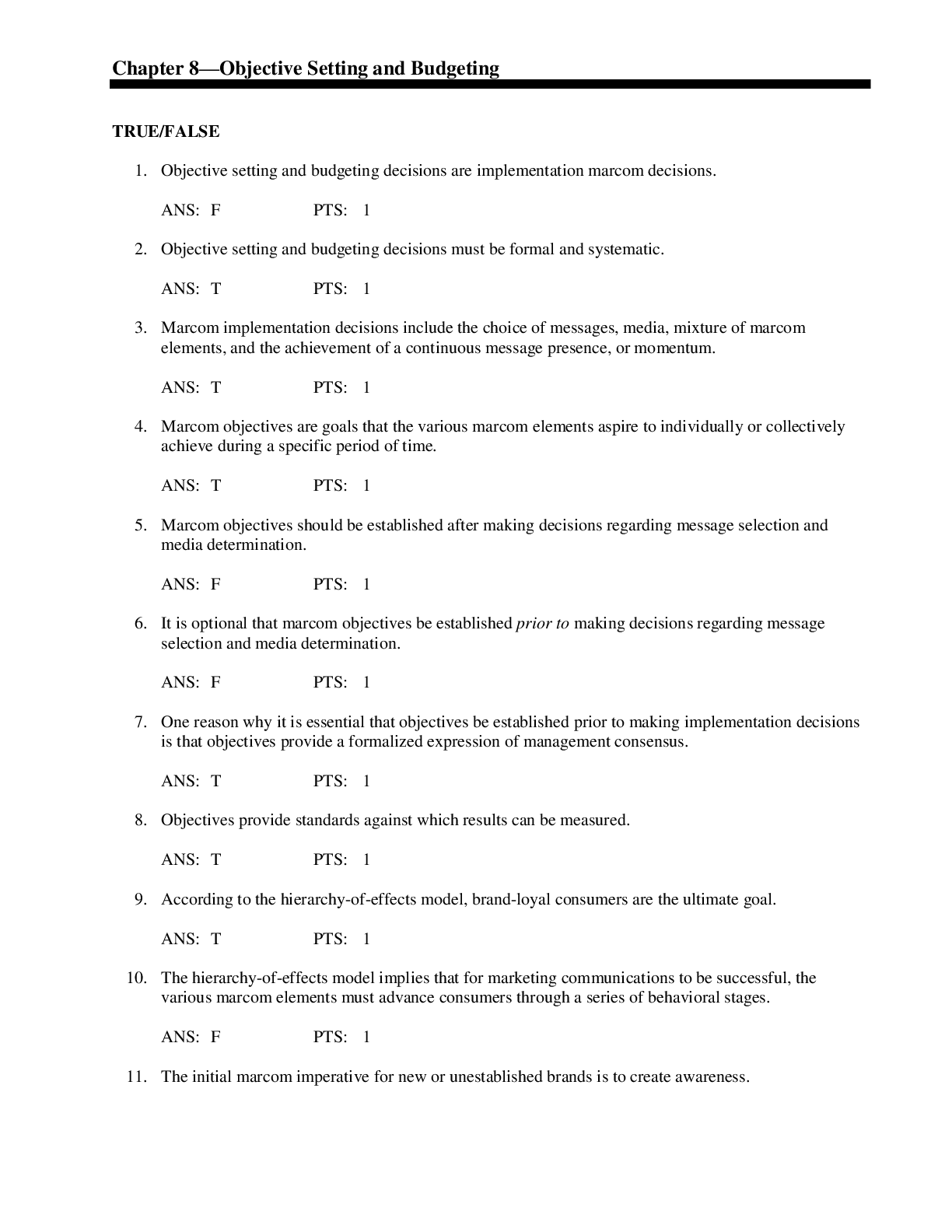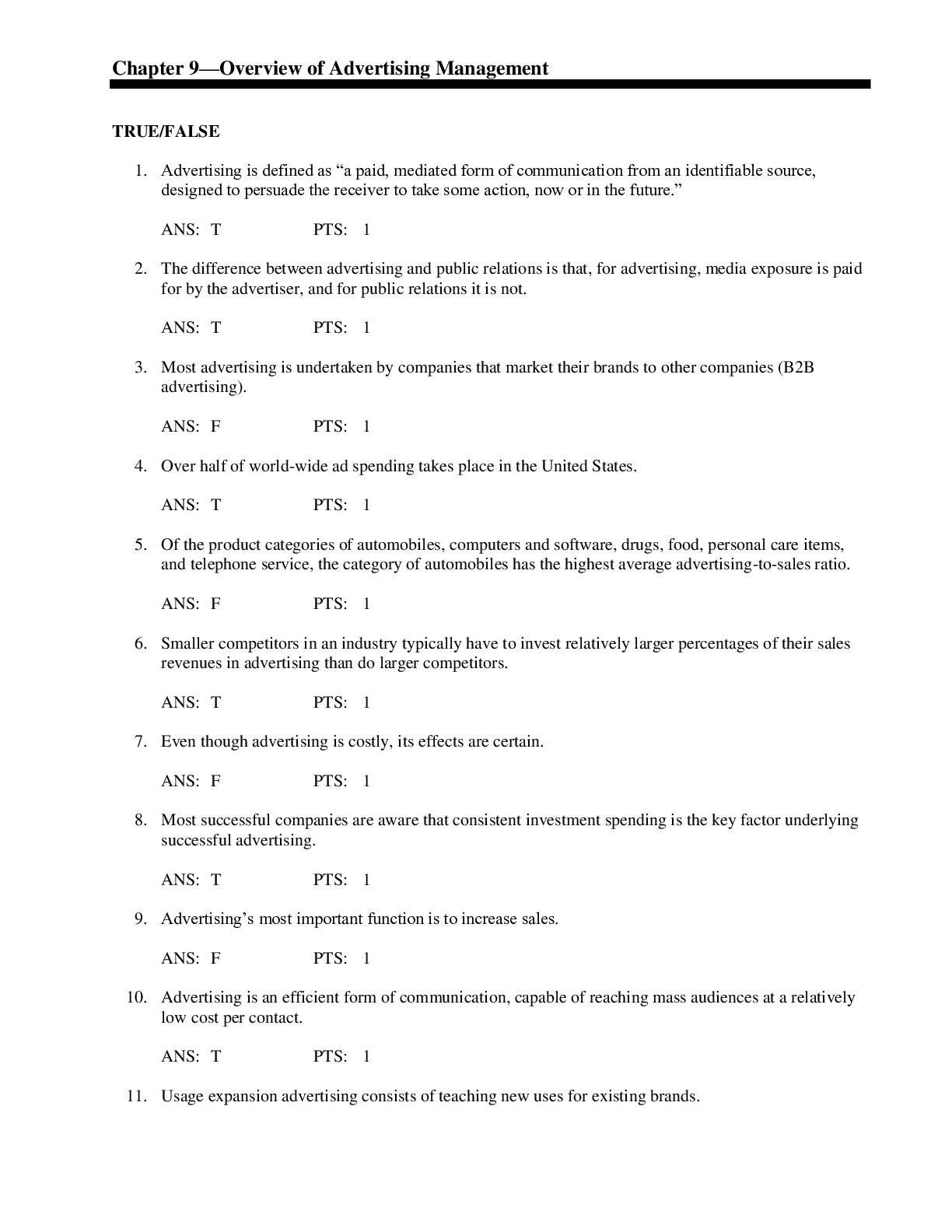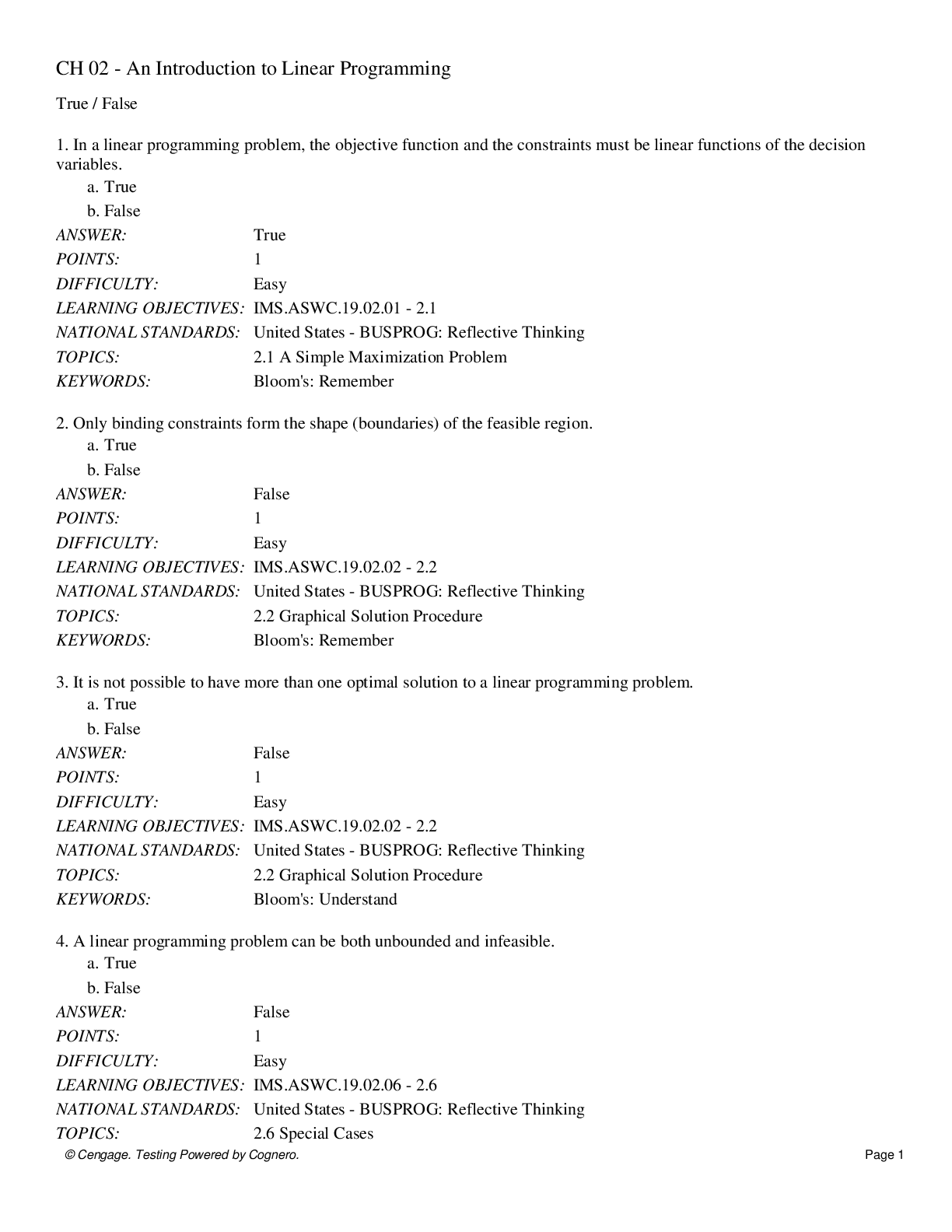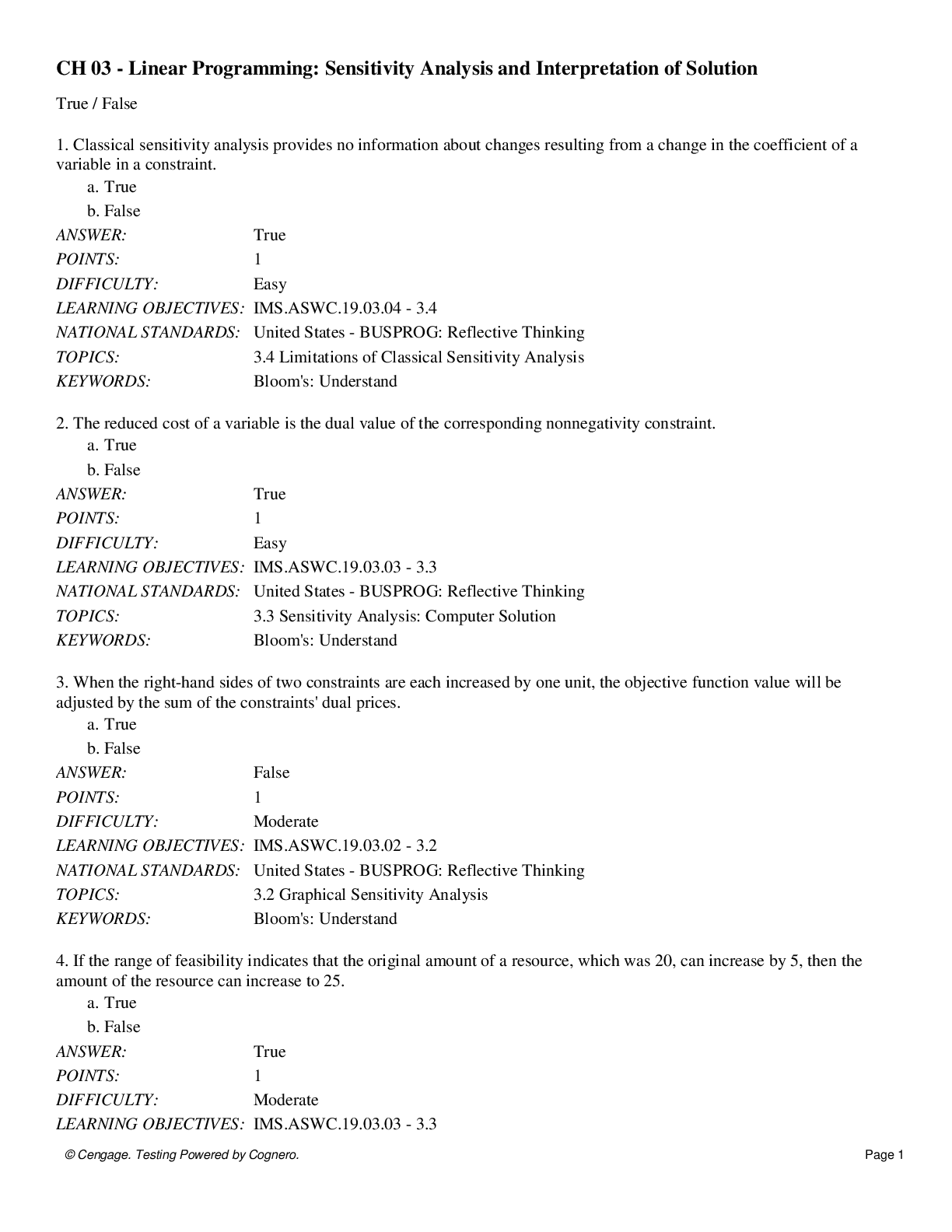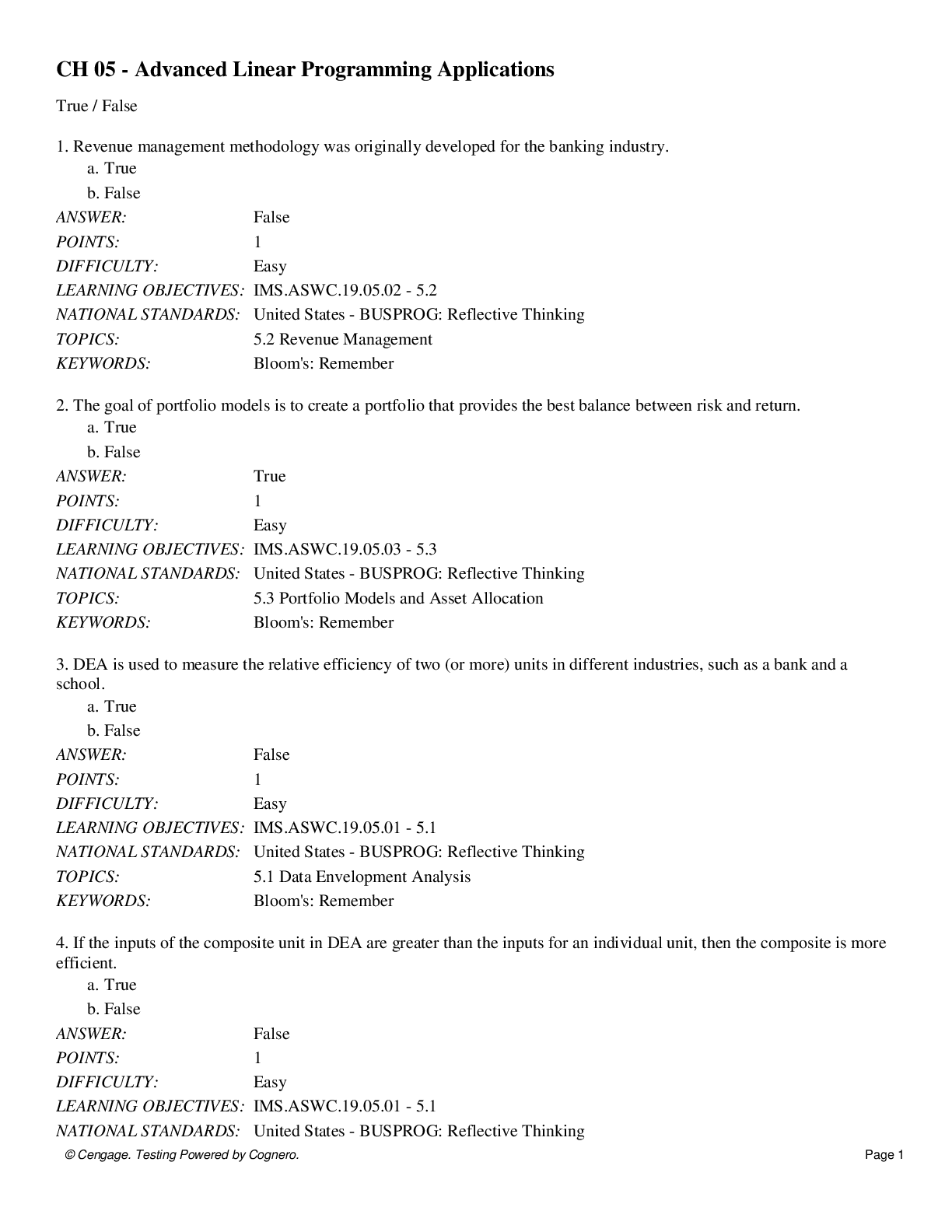Biology > QUESTIONS & ANSWERS > Chapter 08—DNA STRUCTURE AND FUNCTION. Questions and Answers (All)
Chapter 08—DNA STRUCTURE AND FUNCTION. Questions and Answers
Document Content and Description Below
Multiple Choice 1. On Exhibit 8.1, a nucleosome is identified by number a. 2. b. 6. c. 3. d. 1. e. 5. 2. On Exhibit 8.1, the DNA double helix is identified by number... a. 2. b. 3. c. 4. d. 5. e. 6. 3. On Exhibit 8.1, a chromosome is represented by number: a. 2 b. 3 c. 4 d. 5 e. 6 4. On Exhibit 8.1, a set of condensed chromosomes within a nucleus is represented by number: a. 1 b. 2 c. 3 d. 4 e. 5 ANSWER: a POINTS: 1 REFERENCES: Section 8.3 What is a chromosome? KEYWORDS: Bloom's: Apply NOTES: New 5. After chromosomes are duplicated, each of the new copies is called a _____. a. centromere b. sister chromatid c. replicate d. clone e. nucleosome ANSWER: b POINTS: 1 REFERENCES: Section 8.3 What is a chromosome? KEYWORDS: Bloom's: Remember NOTES: Modified 6. Within chromosomes, DNA is wrapped around proteins called a. karyotypes. b. chromatids. c. nucleosomes. d. centromeres. e. histones. ANSWER: e POINTS: 1 REFERENCES: Section 8.3 What is a chromosome? KEYWORDS: Bloom's: Remember 7. A human karyotype showing 22 pairs of autosomes and two X chromosomes would be a. a normal male. b. a normal female. c. an abnormal male. d. an abnormal female. e. a human whose sex cannot be determined. ANSWER: b POINTS: 1 REFERENCES: Section 8.3 What is a chromosome? KEYWORDS: Bloom's: Apply NOTES: Modified 8. The significance of Fred Griffith's experiment in which he used two strains of Streptococcus pneumoniae is that a. the semiconservative nature of DNA replication was finally demonstrated. b. it demonstrated that harmless bacterial cells had become permanently transformed through a change in the bacterial hereditary system. c. it confirmed that each cell of a given species contains the same amount of DNA. d. it demonstrated that radioactively labeled bacteriophages transfer their DNA but not their protein coats to their host bacteria. e. it demonstrated that mice can change the hereditary content of bacteria. ANSWER: b POINTS: 1 REFERENCES: Section 8.1 How was DNA's function discovered? KEYWORDS: Bloom's: Understand NOTES: Modified 9. Which scientist(s) identified the transforming substance involved in changing R bacteria to S? a. Avery and McCarty b. Griffith c. Chargaff d. Hershey and Chase e. Pauling ANSWER: a POINTS: 1 REFERENCES: Section 8.1 How was DNA's function discovered? KEYWORDS: Bloom's: Understand NOTES: Modified 10. Bacteriophages are a. bacteria. b. prions. c. viruses. d. cellular components. e. protistans. ANSWER: c POINTS: 1 REFERENCES: Section 8.1 How was DNA's function discovered? KEYWORDS: Bloom's: Remember NOTES: Modified 11. What was the significance of the Hershey-Chase experiments in which 32P and 35S were used? a. They finally demonstrated the semiconservative nature of DNA replication. b. They demonstrated that harmless bacterial cells had become permanently transformed through a change in the bacterial hereditary system. c. They established that pure DNA extracted from disease-causing bacteria transformed harmless strains into killer strains. d. They demonstrated that radioactively labeled bacteriophages transfer their DNA but not their protein coats to their host bacteria. e. They demonstrated that DNA content of a cell does not vary over time. ANSWER: d POINTS: 1 REFERENCES: Section 8.1 How was DNA's function discovered? KEYWORDS: Bloom's: Understand NOTES: Modified 12. Nucleic acid contains a. sulfur. b. nitrogen. c. potassium. d. iron. e. manganese. ANSWER: b POINTS: 1 REFERENCES: Section 8.2 How was DNA's structure discovered? KEYWORDS: Bloom's: Remember NOTES: Modified 13. The building blocks of nucleic acids are a. amino acids. b. fatty acids. c. monosaccharides. d. nucleotides. e. lipids. ANSWER: d POINTS: 1 REFERENCES: Section 8.2 How was DNA's structure discovered? KEYWORDS: Bloom's: Remember NOTES: Modified 14. Which of the following is not related to the other four? a. amino acids b. nucleotides c. five-carbon sugars d. phosphate groups e. nitrogenous bases ANSWER: a POINTS: 1 REFERENCES: Section 8.2 How was DNA's structure discovered? KEYWORDS: Bloom's: Understand NOTES: Modified 15. Chargaff’s first rule states that a. the amounts of adenine and thymine are identical. b. the DNA molecule is helical. c. the DNA molecule contains deoxyribose. d. the proportion of adenine and guanine differs between different species. e. DNA exhibits a repeating pattern every 0.34 nm. ANSWER: a POINTS: 1 REFERENCES: Section 8.2 How was DNA's structure discovered? KEYWORDS: Bloom's: Remember NOTES: Modified 16. Rosalind Franklin's research contribution was essential in a. discovering the existence of DNA. b. establishing the principles of heredity. c. establishing the structural features of DNA. d. determining the nucleotide sequence of genes. e. determining the tertiary structure of proteins. ANSWER: c POINTS: 1 REFERENCES: Section 8.2 How was DNA's structure discovered? KEYWORDS: Bloom's: Remember NOTES: Modified 17. In DNA, complementary base pairing occurs between a. cytosine and uracil. b. adenine and guanine. c. adenine and uracil. d. adenine and thymine. e. sugar and phosphate. ANSWER: d POINTS: 1 REFERENCES: Section 8.2 How was DNA's structure discovered? KEYWORDS: Bloom's: Remember NOTES: Modified 18. Replication of DNA produces a. RNA molecules. b. only new DNA. c. two DNA strands that are both copies of the parent strand. d. one completely new DNA strand and the old parent strand is degraded. e. new proteins. ANSWER: c POINTS: 1 REFERENCES: Section 8.4 How does a cell copy its DNA? KEYWORDS: Bloom's: Remember NOTES: Modified 19. The role of DNA ligase is to a. join together fragments of DNA. b. replace mispaired bases. c. initiate DNA replication. d. form new DNA polymers. e. break apart hydrogen bonds. ANSWER: a POINTS: 1 REFERENCES: Section 8.4 How does a cell copy its DNA? KEYWORDS: Bloom's: Remember NOTES: Modified Selecting the Exception 20. Four of the five answers listed below are bases used to construct nucleic acids. Select the exception. a. cytosine b. adenine c. thymine d. guanine e. phenylalanine ANSWER: e POINTS: 1 REFERENCES: Section 8.4 How does a cell copy its DNA? KEYWORDS: Bloom's: Remember OTHER: Selecting the Exception 21. Four of the five answers listed below are correctly paired. Select the exception. a. A-C b. C-G c. A-T d. T-A e. purine-pyrimidine ANSWER: a POINTS: 1 REFERENCES: Section 8.4 How does a cell copy its DNA? KEYWORDS: Bloom's: Remember OTHER: Selecting the Exception 22. When DNA replication begins, _____. a. the two DNA strands unwind from each other b. the two DNA strands condense for base transfers c. two DNA molecules bond d. old strands move to find new strands e. the sugar phosphate backbone is degraded ANSWER: a POINTS: 1 REFERENCES: Section 8.4 How does a cell copy its DNA? KEYWORDS: Bloom's: Understand NOTES: New 23. A karyotype is an image of _____ from of a single cell. a. base sequences b. chromosomes c. hereditary information d. clones e. nucleus ANSWER: b POINTS: 1 REFERENCES: Section 8.3 What is a chromosome? KEYWORDS: Bloom's: Understand NOTES: Modified 24. What are the base-pairing rules for DNA? a. A-G, T-C b. A-C, T-G c. A-U, C-G d. A-T, G-C e. A-T, G-U ANSWER: d POINTS: 1 REFERENCES: Section 8.2 How was DNA's structure discovered? KEYWORDS: Bloom's: Remember NOTES: Modified 25. When Avery and McCarty were attempting to identify the substance involved transferring hereditary material, they tested the ability of a bacterial S cell extract to transform R cells after different components of the extract were degraded by enzymes. Which treatment inhibited the ability of the S cell extract to transform R cells? a. DNAse degrading enzymes b. RNAse degrading enzymes c. protein degrading enzymes d. lipid degrading enzymes e. amino acid degrading enzymes ANSWER: a POINTS: 1 REFERENCES: Section 8.1 How was DNA's function discovered? KEYWORDS: Bloom's: Understand NOTES: New 26. The term "DNA sequence" refers to the: a. order of nucleotides in a strand of DNA b. number a nucleotides in a strand of DNA c. number of chromosomes in a nucleus d. number of hydrogen bonds in a strand of DNA e. identity of genes in a strand of DNA ANSWER: a POINTS: 1 REFERENCES: Section 8.2 How was DNA's structure discovered? KEYWORDS: Bloom's: Remember NOTES: New 27. How can only four nucleotides account for the extreme diversity of traits within living things? a. The biochemical structure of nucleotides differs between cell types. b. The nucleotides can base pair with any other nucleotide. c. Nucleotides are arranged in many different sequences. d. Different proteins can be encoded from the same DNA sequence. e. Complex organisms have more than four types of nucleotides. ANSWER: c POINTS: 1 REFERENCES: Section 8.2 How was DNA's structure discovered? KEYWORDS: Bloom's: Analyze NOTES: New 28. When a cell has two complete sets of chromosomes, it is: a. haploid b. duplicated c. diploid d. triploid e. complete ANSWER: c POINTS: 1 REFERENCES: Section 8.4 How does a cell copy its DNA? KEYWORDS: Bloom's: Remember NOTES: New 29. In DNA replication, two copies of a DNA molecule are produced. In each copy, one strand is new, and the other is parental. This process is called: a. semiconservative replication. b. inherited replication. c. conservative replication. d. duplication. e. transcription. ANSWER: a POINTS: 1 REFERENCES: Section 8.4 How does a cell copy its DNA? KEYWORDS: Bloom's: Remember NOTES: New 30. In which direction does DNA synthesis proceed? a. From the beginning of the parent strand b. Wherever DNA ligase is first present c. From the 5' to the 3' end of the DNA strand d. From the 3' to the 5' end of the DNA strand e. From both the 5' and the 3' ends of the DNA strand ANSWER: c POINTS: 1 REFERENCES: Section 8.4 How does a cell copy its DNA? KEYWORDS: Bloom's: Understand NOTES: New 31. Which enzyme assembles new strands of DNA during replication? a. DNA ligase b. DNA synthase c. primers d. DNA polymerase e. hybridization ANSWER: d POINTS: 1 REFERENCES: Section 8.4 How does a cell copy its DNA? KEYWORDS: Bloom's: Remember NOTES: New 32. Which statement best describes a DNA mutation? a. DNA polymerase adds an incorrect base during replication. b. DNA is damaged by UV irradiation. c. A mistake in DNA sequence is repaired during replication. d. A permanent change occurs in the nucleotide sequence of DNA. e. Proofreading during replication replaces a mismatched nucleotide. ANSWER: d POINTS: 1 REFERENCES: Section 8.5 What causes mutations? KEYWORDS: Bloom's: Understand NOTES: New 33. Why do most replication errors occur? a. DNA polymerases work very fast and mistakes are inevitable. b. DNA repair mechanisms do not work well. c. DNA replication is a slow and uncommon process. d. The hydrogen bonds between base pairs are weak. e. DNA ligase often binds incorrect sections of DNA. ANSWER: a POINTS: 1 REFERENCES: Section 8.5 What causes mutations? KEYWORDS: Bloom's: Analyze NOTES: New 34. A genetic mutation may be passed on to offspring if the mutation occurs in what type of cell? a. a cancerous cell b. a dividing cell within the body c. a somatic cell d. an egg or sperm cell e. any cell in the organism ANSWER: d POINTS: 1 REFERENCES: Section 8.5 What causes mutations? KEYWORDS: Bloom's: Understand NOTES: New 35. Proofreading by DNA polymerase must occur before the end of this process to avoid acquiring a mutation: a. cell division b. duplication c. transcription d. translation e. replication ANSWER: e POINTS: 1 REFERENCES: Section 8.5 What causes mutations? KEYWORDS: Bloom's: Understand NOTES: New 36. Which DNA damaging agent can transfer methyl groups (—CH3) to the nucleotide bases in DNA? a. UV light b. Chemicals in tobacco smoke c. Ionizing radiation d. X-rays e. Free radicals ANSWER: b POINTS: 1 REFERENCES: Section 8.5 What causes mutations? KEYWORDS: Bloom's: Understand NOTES: New 37. Which of the following is an example of therapeutic cloning? a. Splitting an embryo into two halves to produce two embryos within a laboratory b. Using cells from a cloned human embryo for medical purposes c. Asexual cloning in bacteria d. Transferring DNA of an adult donor’s body cell into an unfertilized egg e. Splitting of an embryo within the uterus, producing identical twins ANSWER: b POINTS: 1 REFERENCES: Section 8.6 How does cloning work? KEYWORDS: Bloom's: Apply NOTES: New 38. Twins produced by embryo splitting ____ in their DNA sequence. a. are identical to one another b. are identical to the opposite parent c. must be identical to the same parent d. must be identical to at least one parent e. are not identical to each other ANSWER: a POINTS: 1 REFERENCES: Section 8.6 How does cloning work? KEYWORDS: Bloom's: Remember NOTES: New 39. As an embryo develops, cells become specialized and form different types of tissues and organs by expressing different subsets of their DNA. This process is called: a. growth b. development c. differentiation d. maturation e. cloning ANSWER: c POINTS: 1 REFERENCES: Section 8.6 How does cloning work? KEYWORDS: Bloom's: Remember NOTES: New Matching Choose the one most appropriate answer for each. a. discovered that the hereditary system of one strain of bacteria could be transformed by materials from another strain of bacteria b. first to discover DNA and isolate it from fish sperm c. in 1944, reported that DNA was the "transforming principle" d. the first to demonstrate, through the use of radioactive isotopes, that DNA, not protein, was the substance transmitted through generations of cells e. obtained excellent X-ray diffraction photographs that suggested that DNA was a long, thin molecule with regularly repeating structures; also said that DNA had to be helical like a circular stairway REFERENCES: Section 8.2 How was DNA's structure discovered? Section 8.1 How was DNA's function discovered? KEYWORDS: Bloom's: Remember 40. Avery and McCarty ANSWER: c POINTS: 1 41. Rosalind Franklin ANSWER: e POINTS: 1 42. Fred Griffith ANSWER: a POINTS: 1 43. Hershey and Chase ANSWER: d POINTS: 1 44. Friedrich Miescher ANSWER: b POINTS: 1 Answer the question(s) in reference to the five nucleotides listed below. a. guanine b. cytosine c. pyrimidine d. thymine e. uracil REFERENCES: Section 8.2 How was DNA's structure discovered? KEYWORDS: Bloom's: Remember OTHER: Classification Questions 45. Early data indicated that within a species the amount of this was always equal to the amount of adenine. ANSWER: d POINTS: 1 46. This nucleotide is not incorporated into the structure of the DNA helix. ANSWER: e POINTS: 1 47. This nucleotide is a double-ringed molecule. ANSWER: a POINTS: 1 48. If one chain of a DNA molecule had a purine at a given position, this would be its complement on the other chain. ANSWER: c POINTS: 1 49. Two hydrogen bonds connect guanine to this in the DNA molecule. ANSWER: b POINTS: 1 Match the term with the most appropriate description. a. nucleosome b. chromatids c. centromere d. histone e. chromosome REFERENCES: Section 8.3 What is a chromosome? KEYWORDS: Bloom's: Understand NOTES: New 50. Exact copy of a chromosome ANSWER: b POINTS: 1 51. A structure that consists of DNA and associated proteins; carries part or all of a cell’s genetic information. ANSWER: e POINTS: 1 52. A length of DNA wound twice around a proteins ANSWER: a POINTS: 1 53. Constricted region where duplicated chromosomes are attached ANSWER: c POINTS: 1 54. A protein that organizes DNA ANSWER: d POINTS: 1 Select the complementary nucleotide sequence for each: a. AAAGGC b. TGACTG c. GCGCGC d. ACTGAC REFERENCES: Section 8.3 How does a cell copy its DNA? KEYWORDS: Bloom's: Apply NOTES: New 55. ACTGAC ANSWER: c POINTS: 1 56. CGCGCG ANSWER: b POINTS: 1 57. TGACTG ANSWER: d POINTS: 1 58. TTTCG ANSWER: a POINTS: 1 Match the example with the type of cloning. a. embryonic reproductive cloning b. therapeutic cloning c. somatic cell nuclear transfer REFERENCES: Section 8.6 How does cloning work? KEYWORDS: Bloom's: Apply NOTES: New 59. cloning that uses a somatic cell taken from an adult organism ANSWER: c POINTS: 1 60. an unfertilized egg’s nucleus is replaced with the nucleus of a donor’s ANSWER: c POINTS: 1 61. a cow is cloned to make exact copies of the adult cow ANSWER: c POINTS: 1 62. an embryo splits into two in the uterus and identical twins form. ANSWER: a POINTS: 1 63. using a cloned cell to differentiate tissues/organs needed for sick patients ANSWER: b POINTS: 1 64. artificial embryo splitting in a laboratory ANSWER: a POINTS: 1 65. using a cloned cell for medical research ANSWER: b POINTS: 1 66. Trakr, a rescue dog highlighted in Section 8.7, is cloned and five puppies are born from a surrogate mother. ANSWER: c POINTS: 1 Subjective Short Answer 67. The replication seen here is termed a. dominant b. recessive c. conservative d. semiconservative e. hemiconservative ANSWER: d POINTS: 1 REFERENCES: Section 8.4 How does a cell copy its DNA? KEYWORDS: Bloom's: Understand OTHER: Labeling 68. In step b, why have the original strands separated? a. Hydrogen bonds between bases were broken. b. Sugar-phosphate linkages were broken. c. Polymerases stopped functioning. d. Bases repelled each other. e. Water hydrolyzed the bases into their subunits. ANSWER: a POINTS: 1 REFERENCES: Section 8.4 How does a cell copy its DNA? KEYWORDS: Bloom's: Understand OTHER: Labeling NOTES: Modified 69. What is the name of the enzyme adding the bases in step c? a. ligase b. helicase c. DNA polymerase d. primase e. repairase ANSWER: c POINTS: 1 REFERENCES: Section 8.4 How does a cell copy its DNA? KEYWORDS: Bloom's: Remember OTHER: Labeling 70. When step d is completed, the two double stranded DNA molecules formed will be a. identical to each other but not to the parent b. identical to the parent but not to each other c. identical to each other and to the parent d. different from each other and from the parent e. identical to each other and almost like the parent ANSWER: c POINTS: 1 REFERENCES: Section 8.4 How does a cell copy its DNA? KEYWORDS: Bloom's: Understand OTHER: Labeling 71. Describe Griffith's transformation experiment. ANSWER: Griffith infected mice with mixtures of Streptococcus pneumoniae. S cells killed mice, while R cells did not. Killed S cells were also harmless to mice. However, when killed S cells were added to living R cells; the combination killed mice, and living S cells could be isolated from the dead mice. Griffith postulated that something in the killed S cells transformed living R cells to S cells. POINTS: 1 REFERENCES: Section 8.1 How was DNA's function discovered? KEYWORDS: Bloom's: Understand 73. What is the difference between embryo cloning and adult cloning? 74. Show the complementary strand of DNA that forms on this template DNA fragment during replication: 5' GGTTTCTTCAAGAGA3' 75. Match the terms appropriately. a. nitrogen-containing base, sugar, phosphate group(s) b. copy of an organism c. chromosome that does not determine sex d. DNA wrapped around histones e. fills in gaps, seals breaks in a DNA strand f. two chromosomes copies of each g. adds nucleotides to a growing DNA strand ________ nucleosome ________ clone ________ nucleotide ________ diploid ________ DNA ligase ________ DNA polymerase ________ autosome 76. How can a replication error become a permanent mutation? Essay 77. Mutations are permanent changes in a cell’s DNA base sequence. They typically have negative consequences, but they are also the original source of genetic variation and the raw material of evolution. How can mutations accumulate, given that cells have repair systems that fix changes or breaks in DNA strands? 78. Woolly mammoths have been extinct for about 10,000 years, but we occasionally find one that has been preserved in Siberian permafrost. Resurrecting these huge elephantlike mammals may be possible by cloning DNA isolated from such frozen remains. Researchers are now studying the DNA of a remarkably intact baby mammoth recently discovered frozen in a Siberian swamp. What are some of the pros and cons, both technical and ethical, of cloning an extinct animal? 79. Describe the difference between a replication error and a mutation. [Show More]
Last updated: 1 year ago
Preview 1 out of 20 pages
Instant download
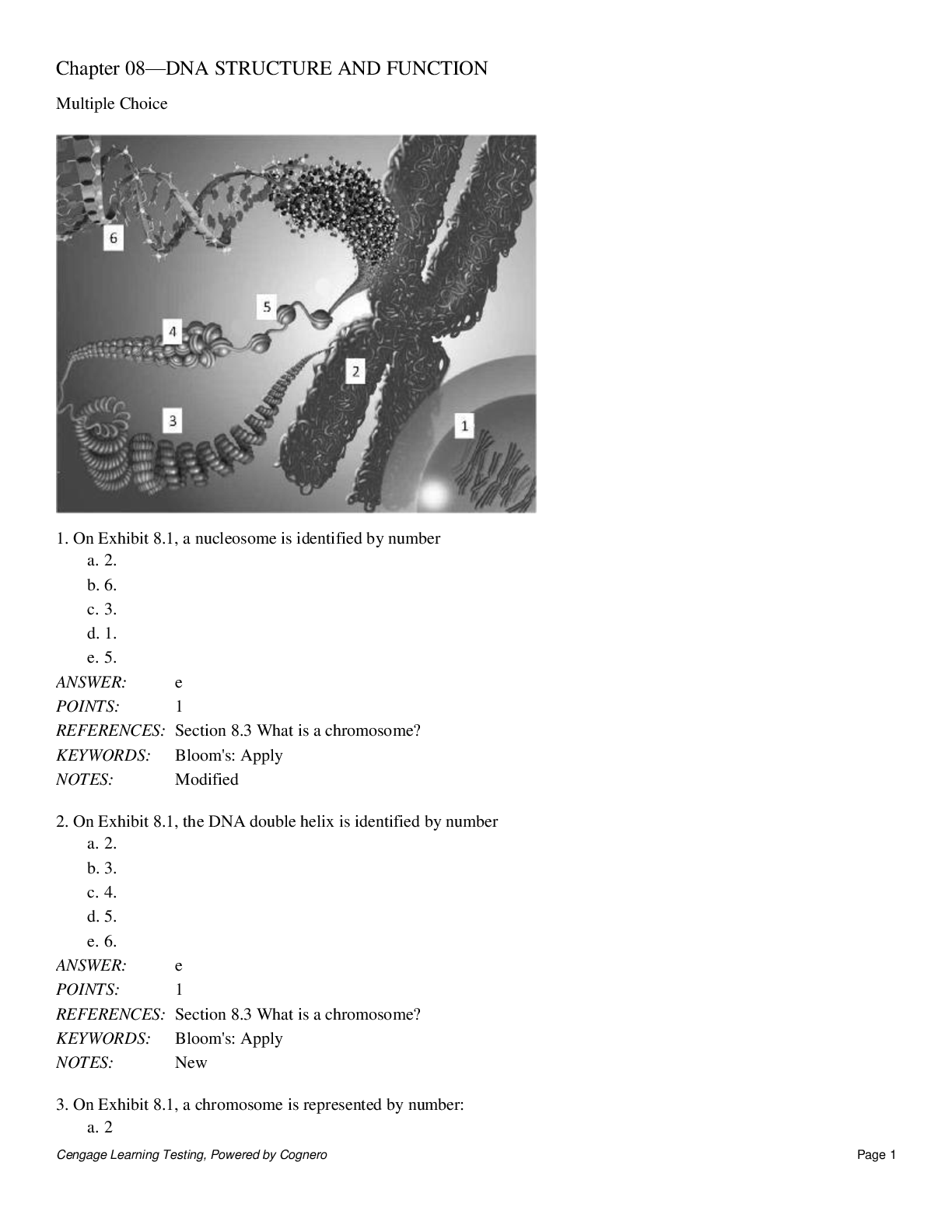
Buy this document to get the full access instantly
Instant Download Access after purchase
Add to cartInstant download
Reviews( 0 )
Document information
Connected school, study & course
About the document
Uploaded On
Nov 08, 2019
Number of pages
20
Written in
Additional information
This document has been written for:
Uploaded
Nov 08, 2019
Downloads
0
Views
313
















